
burntoolong
Fav word rn - "Maya"
10 posts
Latest Posts by burntoolong
ancient greek word of the day: συναστρέω (sunastreō), to be born under the same star


The sun sets over Agra Fort Station as carriages are watered and given a routine inspection. In the background, Jama Masjid Mosque. Uttar Pradesh, India, 1983.
credit- Steve McCurry
Mahashweta Devi and Sharankumar Limbale low key changed my life and the way I look at "aesthetics" of literature and palatability politics. I remember how when we were really young, growing up in Bengal, a pretty popular consensus among the upper and upper-middle classes (even among some lower middle classes of savarna Hindu Bengalis) was that Ashapurna Devi is the go-to author for Bengali feminism and feminist themes, while Mahashweta Devi, outside of selective circles of academic and scholarly vested interests was seen more in an "inappropriate"/"controversial" or grimdark sense. Her novels and short stories always raised eyebrows among the cushy Kolkata babus, who felt "uncomfortable" with the coarse language and explicitly gratuitous details she provided in her work. When I read Shekhar's The Adivasi Will Not Dance when I was 17, I also thought, was it necessary to portray these brutalities so graphically? I was in high school, I did not know about palatability as a concept, and how it plays into dominant-group narratives back then.
And then I grew up, and read Limbale's text, and it was pretty much an eye-opener when he noted that savarnas judge all literature, including the literature of marginality, relative to their own specific lived contexts. This is not just for literature, but all aspects of Indian identity in practice, and it's not, to me, simply an indictment of the alt right, but the left too. Note that even the most self-congratulating Bengali (or Indian in general) leftism is imbued with respectability politics– no wonder, you wouldn't catch your average Kolkata babu mentioning Marichjhapi without crying about how it was all some intentional plot to deface Jyoti Basu.
What I'm trying to say is, if Mahashweta Devi made any "respectable" Bengali uncomfortable, wasn't that the point? Why must she depend on dominant-group aesthetics and mainstream ideas of "literary fiction" to depict military violence against Adivasi people or the Kolkata police brutalities during Naxalbari? Why must her dialogue be "polished"- aka a dialect comprehensible to majority groups? Why should she shy away from depicting abuse, rape and violence when the mainstream Indian media and the govt are doing their utmost best to erase such accounts when it concerns Adivasi or Dalit people?
And here's a twist: Mahashweta Devi was herself a Brahmin, she wasn't an Adivasi or a Dalit voice. So the whole Left condemning her works + BJP removing her writing alongside Dalit authors from university curriculum is just a testament to how fucked our literary scene is. No matter how much we are torn by party politics, two very different political ideologies came together to condemn one writer because God forbid she chose to portray Dalit and Adivasi resistance and rage. You can only imagine how India treats its Dalit authors too.
Anyway, this rant was brought to you by a recent literary discussion with some Bengali elders who were hellbent on convincing me that Mahashweta Devi isn't worth my time and I should pick up an Ashapurna Devi novel instead. So much for playing comrade comrade. No matter how much theory you can spout, it doesn't change that most Indian mainstream savarna politicians, writers and political ideologies are extremely hostile to anything that might remotely posit that they are not perfect in their victimhood. It is true, we do see everything in India from a point of "how does this oppress/marginalize me specifically" rather than "from what privileged perspective am I speaking on identities that my dominant group oppresses". The same is true for literature, and art. This is why we keep yapping on about the British Raj and reclaiming our lost jewels from the Museums but lose our heads when it comes to realising they are not the only Big Bad in Indian history.
Texts mentioned for anybody interested:
Sharankumar Limbale, Towards an Aesthetic of Dalit Literature: Histories, Controversies and Considerations, 2004
Hansda Sowvendra Shekhar, The Adivasi will Not Dance, 2015
Mahashweta Devi, various works including The Mother of 1084 and Draupadi
"A Child’s View from Gaza" was an art exhibition showcasing drawings created by the children of Gaza.







"The captioned illustrations were created by Palestinian children who lived through the Israeli bombardment of Gaza in 2008-09. The pictures were drawn as part of an effort to help children deal with the horrors they had experienced. A Bay Area nonprofit, Middle East Children’s Alliance (MECA), arranged to display a collection of these pictures at the Museum of Children’s Art in Oakland, California. However, under pressure from the Jewish Federation of the East Bay and other organizations, the museum backed out of the agreement at the last minute."

Lisa Wright - Beneath the Strangeness of it, 2020







How to Identify Emotionally Mature People, Adult Children of Emotionally Immature Parents, Lindsay C. Gibson,
ভাষা দিবসের অনেক শুভেচ্ছা সকলকে

“i don’t owe anyone anything” is one of the most incredibly callous and damaging phrases to enter popular vernacular. you owe everyone kindness and consideration, always. understand the idea of a social contract. you cannot reap the benefits of human society and interaction while maintaining such a cold and thankless attitude about it. i mean you can but you’d be a bad person for it
